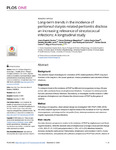Long-term trends in the incidence of peritoneal dialysis-related peritonitis disclose an increasing relevance of streptococcal infections: a longitudinal study

Use este enlace para citar
http://hdl.handle.net/2183/27320
Excepto si se señala otra cosa, la licencia del ítem se describe como Creative Commons Attribution 4.0 International License (CC-BY 4.0)
Colecciones
- GI-FENM - Artigos [114]
- GI-GIRS - Artigos [100]
Metadatos
Mostrar el registro completo del ítemTítulo
Long-term trends in the incidence of peritoneal dialysis-related peritonitis disclose an increasing relevance of streptococcal infections: a longitudinal studyAutor(es)
Fecha
2020-12-21Cita bibliográfica
Santos JE, Rodríguez Magariños C, García Gago L, Astudillo Jarrín D, Pértega S, Rodríguez-Carmona A, García Falcón T, Pérez Fontán M. Long-term trends in the incidence of peritoneal dialysis-related peritonitis disclose an increasing relevance of streptococcal infections: a longitudinal study. PLoS One. 2020 Dec 21;15(12):e0244283.
Resumen
[Abstract}
Background.
The selective impact of strategies for prevention of PD-related peritonitis (PDrP) may have modified, in the long term, the causal spectrum, clinical presentation and outcomes of these infections.
Objectives.
To compare trends in the incidence of PDrP by different microorganisms during a 30-year period, with a particular focus on streptococcal infections. To analyze the clinical presentation and outcomes of these infections. Secondarily, to investigate how the isolation of different species of streptococci can influence the clinical course of PDrP by this genus of bacteria.
Method.
Following a retrospective, observational design we investigated 1061 PDrP (1990–2019). We used joinpoint regression analysis to explore trends in the incidence of PDrP by different microorganisms, and compared the risk profile (Cox), clinical presentation and outcomes (logistic regression) of these infections.
Main results.
Our data showed a progressive decline in the incidence of PDrP by staphylococci and Gram negative bacteria, while the absolute rates of streptococcal (average annual percent change +1.6%, 95% CI -0.1/+3.2) and polymicrobial (+1.8%, +0.1/+3.5) infections tended to increase, during the same period. Remarkably, streptococci were isolated in 58.6% of polymicrobial infections, and patients who suffered a streptococcal PDrP had a 35.8% chance of presenting at least one other infection by the same genus. The risk profile for streptococcal infections was comparable to that observed for PDrP overall. Streptococcal PDrP were associated with a severe initial inflammatory response, but their clinical course was generally nonaggressive thereafter. We did not observe a differential effect of different groups of streptococci on the clinical presentation or outcome of PDrP.
Conclusions.
Time trends in the incidence of PDrP by different microorganisms have granted streptococci an increasing relevance as causative agents of these infections, during the last three decades. This behaviour suggests that current measures of prevention of PDrP may not be sufficiently effective, in the case of this genus of microorganisms.
Palabras clave
Streptococcal infections
Medical risk factors
Staphylococcal infection
Polymicrobial infections
Streptococcus
Gram negative bacteria
Staphylococcus aureus
Staphylococcus
Medical risk factors
Staphylococcal infection
Polymicrobial infections
Streptococcus
Gram negative bacteria
Staphylococcus aureus
Staphylococcus
Versión del editor
Derechos
Creative Commons Attribution 4.0 International License (CC-BY 4.0)
ISSN
1932-6203






